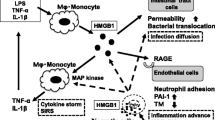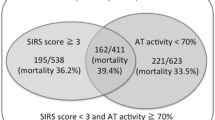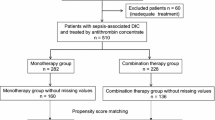Abstract
To determine the relationship between macrophage migration inhibitory factor (MIF) and disseminated intravascular coagulation (DIC) in patients with systemic inflammatory response syndrome (SIRS) and sepsis, and their relationship to multiple organ dysfunction syndrome (MODS) and prognosis, we conducted a prospective cohort study. Forty-eight patients with SIRS or sepsis were classified as 20 DIC and 28 non-DIC patients. MIF, tumor necrosis factor-alpha (TNF-alpha), soluble fibrin, protein C activity (protein C), and plasminogen activator inhibitor-1 (PAI-1) were all measured within 24 h after the patients met the criteria of SIRS or sepsis (day 0), and on days 1 to 4. The number of SIRS criteria that the patients met and the DIC scores were determined simultaneously. In DIC patients, significantly higher levels of MIF, TNF-alpha, soluble fibrin, PAI-1 were found compared with non-DIC patients. We also found significantly lower protein C levels in the DIC patients than in the non-DIC patients. Significant correlations were found between the peak levels of MIF and soluble fibrin in the DIC patients (rs = 0.496, p < 0.0407). All DIC patients had MODS and also showed a higher number of dysfunctioning organs and a poorer prognosis than the non-DIC patients. A simple logistic regression analysis showed the peak MIF levels and DIC significantly to be related to the patients’ death (odds ratio 1.016 and 40.5; p < 0.0409, p < 0.0009, respectively). In conclusion, DIC patients with elevated levels of MIF and TNF-alpha had more organ dysfunctions leading to a poor prognosis in a population of SIRS and sepsis patients. MIF may therefore play a role in the inflammatory and thrombotic processes in DIC patients.




Similar content being viewed by others
References
Calandra, T., J. Bernhagen, C. N. Metz, L. A. Spiegel, M. Bacher, T. Donnelly, A. Cerami, and R. Bucala. 1995. MIF as a glucocorticoid-induced modulator of cytokine production. Nature 377:68–71.
Bucala, R., and MIF rediscovered. 1996. Cytokine, pituitary hormone, and glucocorticoid-induced regulator of the immune response. FASEB J. 10:1607–1613.
Calandra, T., and T. Roger. 2003. Macrophage migration inhibitory factor. A regulator of innate immunity. Nature Rev. 3:791–800.
Members of American College of Chest Physicians/Society of Critical Care Medicine Consensus Conference Committee. American College of Chest Physicians/Society of Critical Care Medicine Consensus Conference. 1992. Definitions for sepsis and organ failure and guidelines for the use of innovative therapies in sepsis. Crit. Care Med. 20:864–874.
Bernhagen, J., T. Calandra, R. A. Mitchell, S. B. Martin, K. J. Tracey, W. Voelter, K. R. Manogue, A. Cerami, and R. Bucala. 1993. MIF is a pituitary-derived cytokine that potentiates lethal endotoxemia. Nature 365:756–759.
Bozza, M., A. R. Satoskar, G. Lin, B. Lu, A. A. Humbles, C. Gerard, and J. R. David. 1999. Targeted disruption of migration inhibitory factor gene reveals its critical role in sepsis. J. Exp. Med. 189:341–346.
Calandra, T., B. Echtenacher, D. L. Roy, J. Pugin, C. N. Metz, L. Hültner, D. Heumann, D. Männel, R. Bucala, and M. P. Glauser. 2000. Protection from septic shock by neutralization of macrophage migration inhibitory factor. Nature Med. 6:164–170.
Gando, S., J. Nishihira, S. Kobayashi, Y. Morimoto, S. Nanzaki, and O. Kemmotsu. 2001. Macrophage migration inhibitory factor is a critical mediator of systemic inflammatory response syndrome. Intensive Care Med. 27:1187–1193.
Lehmann, L. E., U. Novender, S. Schroeder, T. Pietsch, C. Putensen, A. Hoeft, and F. Stüber. 2001. Plasma levels of macrophage migration inhibitory factor are elevated in patients with severe sepsis. Intensive Care Med. 27:1412–1415.
Beishuizen, A., L. G. Thijs, C. Haanen, and I. Vermes. 2001. Macrophage migration inhibitory factor and hypothalamo-pituitary-adrenal function during critical illness. J. Clin. Endocrinol. Metab. 86:2811–2816.
Bozza, F., R. N. Gomes, A. M. Japiassu, M. Soares, H. C. Castro-Faria-Neto, P. T. Bozza, and M. T. Bozza. 2004. Marophage migration inhibitory factor levels correlate with fatal outcome in sepsis. Shock 22:309–313.
Esmon, C. T. 2003. Inflammation and thrombosis. J. Thromb. Haemost. 1:1343–1348.
Nishihira, J., Y. Mizue, and W. Sakamoto. 1999. Induction of T-kininogen and tumor necrosis factor-alpha by macrophage migration inhibitory factor in vivo. Semin. Thromb. Haemost. 25:557–562.
Shimizu, T., J. Nishihira, H. Watanabe, R. Abe, A. Honda, T. Ishibashi, and H. Shimizu. 2004. Macrophage migration inhibitory factor is induced by thrombin and factor Xa in endothelial cells. J. Biol. Chem. 279:13729–13737.
Knaus, W. A., E. A. Draper, D. P. Wanger, and J. E. Zimmerman. 1985. APACHE II: a severity classification system. Crit. Care Med. 13:818–829.
Murray, J. F., M. A. Matthay, J. M. Luce, and M. R. Flick. 1988. An expanded definition of the adult respiratory distress syndrome. Am. Rev. Respir. Dis. 138:720–723.
Gando, S., T. Kameue, S. Nanzaki, and Y. Nakanishi. 1996. Disseminated intravascular coagulation is a frequent complication of systemic inflammatory response syndrome. Thromb. Haemost. 75:224–228.
Taylor, F. B. Jr., C. H. Toh, W. K. Hoots, H. Wada, and M. Levi. 2001. Toward definition, clinical and laboratory criteria, and a scoring system for disseminated intravascular coagulation. Thromb. Haemost. 86:1327–1330.
Onodera, S., K. Suzuki, K. Kaneda, M. Fuinaga, and J. Nishihira. 1999. Growth factor-induced expression of macrophage migration inhibitory factor in osteoblasts: relevance to the plasminogen activator system. Semin. Thromb. Haemost. 25:563–567.
Schmidt-Supprian, M., C. Murphy, B. While, M. Lawler, A. Kapurniotu, W. Voelter, O. Smith, and J. Bernhagen. 2000. Activated protein C inhibits tumor necrosis factor and macrophage migration inhibitory factor production in monocytes. Eur. Cytokine. Netw. 11:407–413.
Hamano, S., S. Tanaka, Y. Takeda, M. Umeda, and Y. Sakata. 2002. A novel monoclonal antibody to fibrin monomer and soluble fibrin for the detection of soluble fibrin in plasma. Clin. Chim. Acta 318:25–32.
Levi, M., and H. ten Cate. 1999. Disseminated intravascular coagulation. N. Engl. J. Med. 341:586–592.
Furukawa, M. 2004. Anti-MIF monoclonal antibody inhibits LPS-stimulated expression of tissue factor. Hokkaido Medical Journal. 79: 523–532. (In Japanese).
Acknowledgements
We thank Miss Y. Mizue of Sapporo Immunodiagnostic Laboratories for assistance in measuring the MIF. This work was supported in part by a Grant-in Aid for Scientific Research from the Ministry of Education, Science, Sports and Culture of Japan (2002-14657379).
Author information
Authors and Affiliations
Corresponding author
Rights and permissions
About this article
Cite this article
Gando, S., Sawamura, A., Hayakawa, M. et al. High Macrophage Migration Inhibitory Factor Levels in Disseminated Intravascular Coagulation Patients with Systemic Inflammation. Inflammation 30, 118–124 (2007). https://doi.org/10.1007/s10753-007-9027-1
Received:
Accepted:
Published:
Issue Date:
DOI: https://doi.org/10.1007/s10753-007-9027-1




